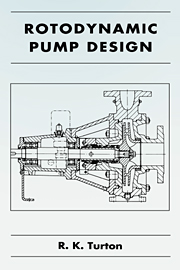Book contents
- Frontmatter
- Contents
- Preface
- Symbols
- 1 Fundamental principles
- 2 Cavitation in pumps
- 3 Centrifugal pump principles
- 4 Principles of axial and mixed flow pumps
- 5 Flow calculations in pumps and an introduction to computer aided techniques
- 6 Single stage centrifugal pump design
- 7 The design of axial and mixed flow pumps
- 8 Basic design principles of shafts, bearings and seals, and selection of drive
- 9 Pump design for difficult applications
- 10 An introduction to the next stage in the pump design process
- References
- Index
4 - Principles of axial and mixed flow pumps
Published online by Cambridge University Press: 29 September 2009
- Frontmatter
- Contents
- Preface
- Symbols
- 1 Fundamental principles
- 2 Cavitation in pumps
- 3 Centrifugal pump principles
- 4 Principles of axial and mixed flow pumps
- 5 Flow calculations in pumps and an introduction to computer aided techniques
- 6 Single stage centrifugal pump design
- 7 The design of axial and mixed flow pumps
- 8 Basic design principles of shafts, bearings and seals, and selection of drive
- 9 Pump design for difficult applications
- 10 An introduction to the next stage in the pump design process
- References
- Index
Summary
Introduction
Typical flow paths for axial and mixed flow machines are shown in Figure 4.1. Axial flow pumps are usually fitted with a rotor only, so that there is very little pressure recovery after the impeller and even where outlet guide vanes are fitted their main function is to remove any outlet swirl from the flow. Mixed flow pumps may either be as shown in Figure 4.1(b) without outlet guide vanes, or as in many machines, for example in the bulb or bore hole pumps, guide vanes are fitted to improve the flow into the second stage of the assembly.
Unlike the centrifugal pump, the performance in axial machines in particular is a function of the action of blade profiles. Only in mixed flow pumps with many blades is the dominant fluid dynamic action that of the passages as in centrifugal machines.
The fundamental relations have been introduced in Chapter 1, and the application of the Euler equation was demonstrated. In this chapter data for isolated aerofoils is discussed, as it applies to axial machinery, and the concepts of radial equilibrium and stall are introduced. This material forms the basis of empirical design techniques, where it is assumed that all stream surfaces are cylindrical. This is only approximately true in axial machines, and in mixed flow machines it is necessary to establish a number of stream surfaces and then either use the axial data along each surface, or use more advanced analytic fluid dynamic solutions based on the surfaces. This chapter therefore outlines an approach to stream surface shape determination and to mixed flow empirical and analytic solutions.
- Type
- Chapter
- Information
- Rotodynamic Pump Design , pp. 60 - 79Publisher: Cambridge University PressPrint publication year: 1994



